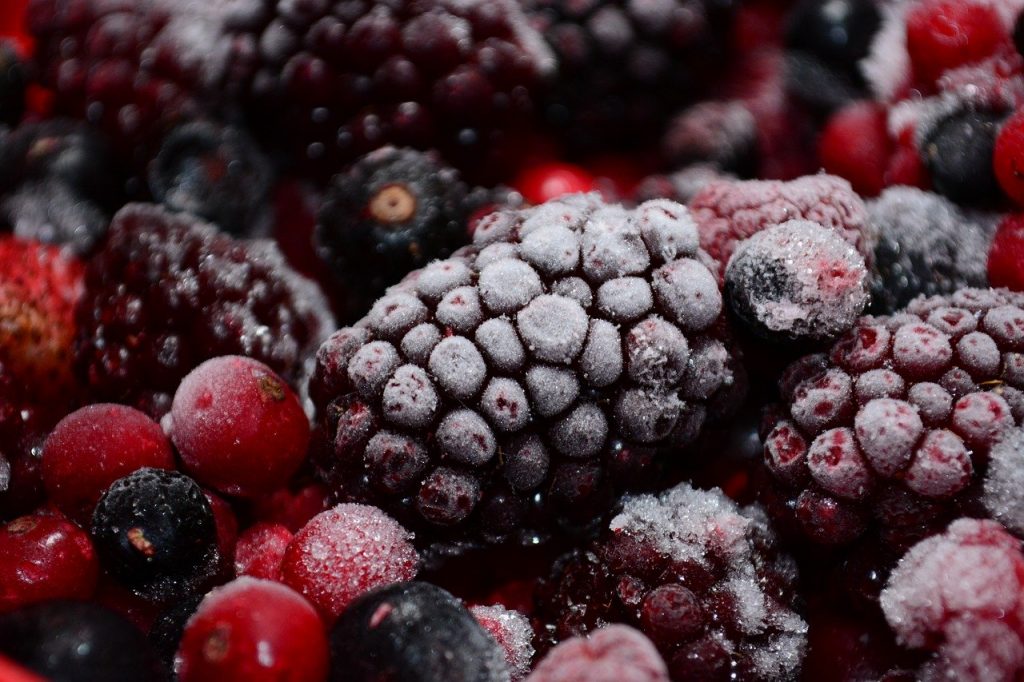
Preserving Food Quality, Safety, and Nutrition
Freezing is a simple and generally low-cost method of preserving food which can capture the flavor of fruits and vegetables at their peak. Like other methods of preservation, freezing extends access to seasonal produce but unlike some methods, freezing conserves the original taste without the addition of sugar, salt, or microbial cultures which would result in a change in taste.
How Freezing Preserves Nutrients
- Storing food below 0°F helps to slow chemical and biological reactions that contribute to nutrient, flavor, and color degradation in fresh fruits and vegetables. Freezing produce quickly after harvest or purchase allows for optimal nutrient and quality preservation.
- Freezing preserves food by slowing the growth of microorganisms that can lead to spoilage and possible foodborne illness. When food thaws, bacterial growth continues, so it is important to maintain proper freezing temperatures of 0°F or below.
- Chemical compounds in fresh foods, called enzymes, start to impact nutrient value immediately after harvest. To preserve optimal nutrition, most vegetables should be blanched before freezing to inactivate enzymes. Blanching also helps to maintain flavor and color during storage. For more information on blanching vegetables read the CSU Extension fact sheet: Freezing Vegetables.
- Some fruits also require treatment before freezing to inactivate enzymes. Fruits that tend to brown when cut, like apples and pears, should be treated with ascorbic acid or lemon juice to preserve color and nutrients. For more information on preparing fruit to freeze, read the CSU Extension fact sheet: Freezing Fruits.
Preserving Flavor and Texture of Frozen Foods
Changes in Flavor and Odor Characteristics
Frozen foods can take on undesirable odors and flavors from other foods in the freezer. Avoid these changes by using air-tight storage containers and removing as much air as possible from containers or freezer bags before freezing.
Freezer Burn
Freezer burn also results when foods are exposed to air in the freezer. Air exposure oxidizes and dehydrates food resulting in dry and leathery areas. Prevent freezer burn by using air-tight storage containers and limiting space within freezer bags or containers (while leaving enough space for expansion during freezing).
Fruit Freezing Tip:
To make texture changes of frozen fruit less noticeable, blend or serve in a frozen or partially thawed state.
Veggie Freezing Tip: Texture changes in frozen vegetables are less noticeable in soups or sauces.
Thawing Tip: To thaw large items, such as a turkey or roast, allow one day in the refrigerator for every 5 pounds of weight.
Texture
Texture changes often occur in frozen foods like fruits, vegetables, and fresh meats that contain large amounts of water. Ice crystals form as water freezes breaking through cell walls. When food is thawed, the punctured cells leak water resulting in a softer product. Textural changes can be minimized by reducing the time it takes to freeze food. When food is frozen rapidly, smaller ice crystals form causing less damage to cell walls while slower freezing produces larger ice crystals and more damage to cell walls. Freezing foods in smaller batches allows quicker freezing and results in a higher quality product.
Thawing Frozen Foods
Thawing is an important step for both food safety and food quality. Frozen foods should be thawed in the refrigerator, in cold water, or in a microwave oven, not at room temperature. Thawing foods should be kept at 40°F or below to inhibit microbial growth.
- Refrigeration is the safest way to thaw frozen foods. Use a thermometer to ensure your refrigerator stays below 40°F. Small frozen items may thaw overnight, but larger items may take a few days. Place thawing foods in a pan or dish to catch drippings.
- Cold Water can be used to thaw packaged foods safely if the water is changed every 30 minutes.
- Use a microwave oven to thaw frozen foods only if you plan to consume or cook them right away. Microwaves can create hot spots which may fall within the temperature danger zone of 40°F-140°F where bacterial growth is accelerated.
Quick Facts….
- Freezing foods at the peak of ripeness is one of the best ways to preserve nutrients, flavors, and colors.
- Although freezing extends the keeping time of food, quality will decrease when food exceeds its recommended storage time.
- For optimal storage times visit the Food Freezing Guide from North Dakota State University.


